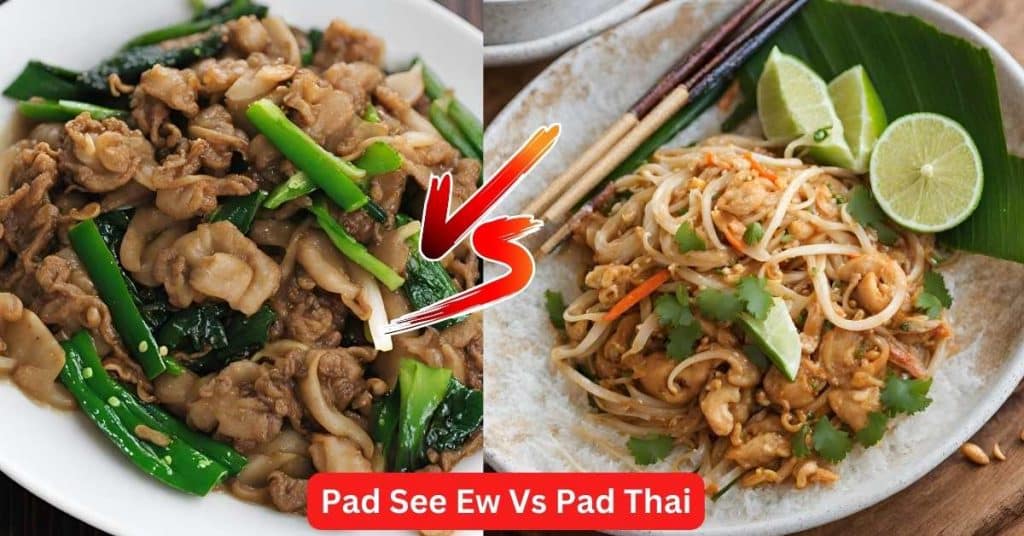The main difference between Pad See Ew and Pad Thai is that Pad See Ew is characterized by its savory taste from soy sauce and its use of wide rice noodles, which provide a chewy texture. Pad Thai, on the other hand, is known for its balance of sweet, sour, and salty flavors, coming from tamarind paste and fish sauce, and it uses thinner rice noodles that absorb the complex sauce.

The key differences between Pad See Ew and Pad Thai
Flavor Profile:
- Pad See Ew has a more straightforward, savory flavor profile dominated by the taste of soy sauce and a slight sweetness.
- Pad Thai offers a complex, balance of sweet, sour, and salty flavors, thanks to the tamarind sauce, fish sauce, and sugar.
Ingredients:
- Pad See Ew uses wide rice noodles, which are stir-fried with a darker soy sauce, typically including Chinese broccoli and a choice of protein like chicken, pork, or beef.
- Pad Thai uses thinner rice noodles and is mixed with a tangy tamarind paste, fish sauce, bean sprouts, egg, tofu, and often shrimp or chicken, garnished with peanuts, lime, and sometimes chili flakes.
Cooking Method:
- Pad See Ew is cooked on a very high heat, which gives the noodles a characteristic charred flavor, known as ‘wok hei’.
- Pad Thai is cooked over medium heat, allowing the sauce to reduce and coat the noodles and ingredients evenly, without the smoky flavor.
Pad See Ew and Pad Thai Similarities
- Base Ingredient: Both dishes are centered around rice noodles, making them gluten-free options in Thai cuisine.
- Protein Variety: They can be made with a variety of proteins such as chicken, beef, pork, shrimp, or tofu, catering to different dietary preferences.
- Stir-Fried Technique: Each dish is stir-fried, a common cooking method in Thai cuisine, which contributes to the quick cooking process and the development of rich flavors.
- Street Food Origins: They are popular street food dishes in Thailand, known for their quick preparation and as staple offerings at Thai restaurants worldwide.
- Customizable Heat Level: Both dishes can be customized for spiciness. While traditionally not very spicy, diners can add chili flakes or fresh chilies to suit their taste.
- Garnishes and Add-Ons: They often come with a set of garnishes like lime wedges and are commonly served with a side of fresh vegetables, such as bean sprouts for Pad Thai and Chinese broccoli for Pad See Ew.
- Culinary Staples: Pad See Ew and Pad Thai are staples in Thai cuisine and have gained international popularity, often serving as an introduction to Thai food for many people.
- Vegetarian Options: It’s easy to make vegetarian versions of both dishes by omitting the meat and substituting with tofu and vegetables, without losing the essence of their traditional flavors.
These commonalities reflect the versatile and adaptive nature of Thai cuisine, embracing different tastes while maintaining a distinctive Thai culinary identity.
The Tale of Two Noodles: Pad See Ew Meets Pad Thai
Imagine walking down the bustling streets of Bangkok, the air filled with the scent of spices and sizzling woks. Among the myriad of Thai street foods, two dishes stand out: the savory Pad See Ew and the tangy Pad Thai. Both are noodle dishes with a heritage as rich as Thailand itself, yet they offer distinct experiences for the taste buds.
Pad See Ew: The Comforting Hug of Thai Cuisine
Pad See Ew is like that warm, comforting hug from a dear friend. It’s the dish you turn to when you need something hearty and fulfilling. Wide rice noodles wok-tossed with a generous splash of soy sauce, mingling with crisp vegetables and your choice of protein, usually chicken, beef, or tofu. The magic of Pad See Ew lies in its simplicity and the charred flavor from the wok’s high heat – a technique called ‘wok hei’ that’s pivotal in Asian cooking.
Pad Thai: The Zesty Party Starter
On the flip side, Pad Thai is the life of the party. It’s vibrant, it’s zesty, and it’s all about balance. Thin rice noodles are tossed in a tamarind-based sauce, with a zing of lime, a hint of fish sauce, and a sprinkle of sugar, usually topped with crushed peanuts and fresh herbs. Every mouthful of Pad Thai is a symphony of sweet, sour, salty, and nutty notes, making it a dish that truly dances on the palate.
A Dance of Ingredients: Wide Versus Thin Noodles
The choice of noodles in both dishes is a dance of textures. Pad See Ew embraces the chewiness of wide rice noodles that soak up the sauce and provide a satisfying bite. Pad Thai, in contrast, opts for thinner noodles that are more about the delicate interplay with the tamarind sauce and the crunch of bean sprouts and peanuts.
The Sauce Boss: Soy Versus Tamarind
If Pad See Ew and Pad Thai were to have a sauce-off, it’d be soy sauce versus tamarind paste. Pad See Ew’s soy sauce is all about the umami, giving the dish a deep, savory character. Pad Thai’s tamarind paste brings a fruity tartness that cuts through the sweetness and creates its signature flavor.
From Wok to Plate: It’s All in the Technique
The cooking techniques also put these dishes at odds. Pad See Ew asks for a hotter, faster toss to get that elusive smoky essence. Pad Thai, while also stir-fried, is more about the toss and turn, giving ingredients time to mingle and marry flavors.
A Feast for the Eyes: Presentation Matters
When served, Pad See Ew often comes to the table with a humble elegance, while Pad Thai is typically garnished with a wedge of lime, a handful of peanuts, and perhaps a few sprigs of cilantro, making it a feast for the eyes as well as the stomach.
Pad See Ew Recipe Outline:
Ingredients:
- Wide rice stick noodles
- Protein of choice (chicken, beef, pork, tofu)
- Garlic, minced
- Chinese broccoli or regular broccoli
- Dark soy sauce
- Light soy sauce
- Oyster sauce
- Sugar
- Eggs
- Vegetable oil
Instructions:
- Soak the rice noodles in warm water until they’re soft.
- Heat oil in a wok or large frying pan over high heat.
- Add garlic and your protein, stir-fry until cooked.
- Push the protein to one side, crack eggs into the pan, and scramble.
- Add the noodles, followed by the dark and light soy sauces, oyster sauce, and a bit of sugar.
- Toss everything quickly so the noodles get a nice char without burning.
- Add the Chinese broccoli and stir-fry until the leaves wilt.
- Serve hot with optional chili flakes and a wedge of lime.
Pad Thai Recipe Outline:
Ingredients:
- Thin rice noodles
- Protein of choice (chicken, shrimp, tofu)
- Garlic, minced
- Tamarind paste
- Fish sauce
- Palm sugar or brown sugar
- Eggs
- Bean sprouts
- Chives or green onions
- Ground peanuts
- Lime wedges
- Vegetable oil
- Optional chili flakes
Instructions:
- Soak the rice noodles in warm water until pliable.
- Combine tamarind paste, fish sauce, and sugar to make the Pad Thai sauce.
- Heat oil in a wok or large pan over medium heat.
- Add garlic and protein, cooking until the protein is nearly done.
- Push protein aside, add eggs to the pan, and scramble them.
- Add noodles and pour the Pad Thai sauce over them, tossing everything to coat.
- Stir in bean sprouts and chives, cook until just wilted.
- Serve garnished with ground peanuts, fresh lime wedges, and chili flakes if desired.
Remember, these outlines are starting points. Cooking is an art, and Thai cuisine especially so, where tasting and adjusting as you go is part of the process. Enjoy your cooking adventure!
The Verdict: Which Dish Wins Your Heart?
Ultimately, the choice between Pad See Ew and Pad Thai might just boil down to your mood. Are you seeking comfort or adventure? Do you yearn for the embrace of soy or the tang of tamarind? Why not both? After all, the heart of Thai cuisine is its variety and the joy of discovering that variety on a plate.
So, there you have it, folks – a friendly face-off between two of Thailand’s most beloved noodle dishes. Whether you’re a Pad See Ew enthusiast or a Pad Thai fanatic, one thing is for sure: Thai cuisine will always have something to delight and surprise you. Happy eating!









Leave a Comment